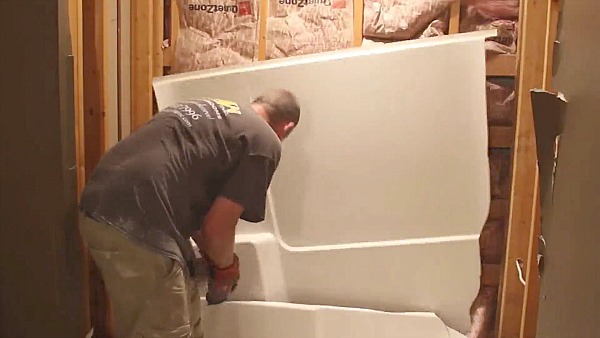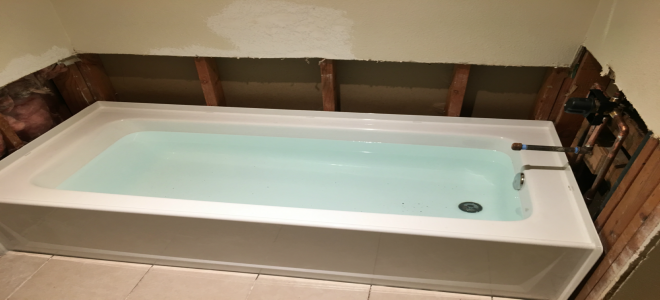Exactly How to Replace a Tub
Exactly How to Replace a Tub
Blog Article
Almost everyone maintains their private conception involving How to Install a Bathtub Yourself.

Installing a bath tub isn't precisely brain surgery, however it does call for solid plumbing, woodworking, as well as sometimes, tiling abilities. Replacing an old bath tub with a brand-new one is also a moderately hard project. If the old bathtub is conveniently available, the job can relocate quickly; if you need to open up a wall to eliminate the old bathtub and position the brand-new bath tub, the task is a lot harder. In either instance, the project is within a house handyman's skills, although you will need a helper to leave the old tub as well as embeded in the new one. Ensure you have certified on your own for the job and are comfortable trying it. As opposed to hiring a professional to take control of a halfway-completed task, it is better to consider employing one before you start. Opportunities are you might need a professional plumber to make tube links.
This write-up will certainly aid you install a new tub in your shower room if you have actually currently gotten a new tub and also do not require to transform the arrangement of your previous supply of water pipelines.
Your tools and product list need to comprise the following:
Planning for the Installment
To start with, the sustaining frame supplied with the bath should be fitted (if required) according to the maker's guidelines. Next off, fit the taps or mixer to the bathtub. When fitting the tap block, it is essential to ensure that if the tap includes a plastic washing machine, it is fitted in between the bathroom and also the faucets. On a plastic bathroom, it is additionally reasonable to fit a supporting plate under the taps unit to prevent strain on the bathtub.
Fit the flexible tap connectors to the bottom of the two taps using 2 nuts and also olives (occasionally provided with the bathtub). Fit the plug-hole electrical outlet by smearing mastic filler round the sink electrical outlet hole, and after that pass the outlet through the hole in the bathroom. Use the nut supplied by the producer to fit the plug-hole. Analyze the plug-hole electrical outlet for an inlet on the side for the overflow pipeline.
Next off, fit completion of the adaptable overflow pipeline to the overflow electrical outlet. Afterwards, screw the pipeline to the overflow face which should be fitted inside the bath. Make sure you use all of the provided washing machines.
Link the catch to the bottom of the waste electrical outlet on the tub by winding the string of the waste electrical outlet with silicone mastic or PTFE tape, as well as screw on the trap to the outlet. Connect the bottom of the overflow tube in a similar manner.The bathroom need to currently prepare to be suited its last placement.
Removing Old Touches
If you require to change old taps with new ones as a part of your installation, then the first thing you need to do is separate the water. After doing so, activate the faucets to drain pipes any type of water staying in the system. The process of removing the existing faucets can be rather troublesome because of the restricted access that is often the case.
Make use of a container wrench (crowsfoot spanner) or a faucet tool to undo the nut that connects the supply pipelines to the faucets. Have a fabric ready for the remaining water that will come from the pipes. As soon as the supply pipelines have been removed, use the very same tool to loosen up the nut that holds the taps onto the bath/basin. You will certainly need to quit the single faucets from transforming during this procedure. Once the faucets have been removed, the holes in the bath/basin will certainly have to be cleansed of any type of old securing compound.
Prior to proceeding to fit the brand-new taps, contrast the pipe links on the old taps to the brand-new taps. If the old faucets are longer than the new faucets, then a shank adapter is needed for the new faucets to fit.
Setting up the Bath tub
Utilizing the two wood boards under its feet, position the tub in the needed position. The wood boards are helpful in uniformly spreading out the weight of the bath tub over the area of the boards as opposed to focusing all the weight onto 4 small factors.
The next objective is to make sure that the bathtub is leveled all round. This can be achieved by checking the spirit level as well as readjusting the feet on the tub until the level reviews level.
To mount faucets, fit all-time low of the outermost flexible faucet connector to the proper supply pipeline by making a compression join; then do the exact same for the other faucet.
Activate the water supply as well as check all joints and brand-new pipework for leaks and tighten them if essential. Fill the bathtub as well as also inspect the overflow outlet and also the typical electrical outlet for leaks.
Ultimately, fix the bath paneling as defined in the manufacturer's user's manual. Tiling and also sealing around the bath tub should wait until the tub has actually been made use of at least once as this will resolve it right into its last position.
Fitting New Touches
If the tails of the brand-new taps are plastic, after that you will certainly need a plastic port to stop damages to the string. One end of the connector fits on the plastic tail of the tap as well as the various other end gives a link to the current supply pipes.
If you need to fit a monobloc, then you will need minimizing couplers, which attaches the 10mm pipeline of the monobloc to the basic 15mm supply pipe.
Next, position the tap in the mounting hole in the bath/basin guaranteeing that the washers remain in place between the faucet and also the sink. Secure the tap in place with the manufacturer supplied backnut. When the tap is securely in position, the supply pipelines can be linked to the tails of the taps. The taps can either be attached by utilizing corrugated copper piping or with typical tap connectors. The previous kind must be linked to the tap finishes initially, tightening up just by hand. The supply pipes can later be connected to the various other end. Tighten both ends with a spanner after both ends have been linked.
Tiling Around the Tub
In the area where the bathroom satisfies the tile, it is essential to seal the joins with a silicone rubber caulking. This is important as the installation can move enough to fracture a stiff seal, causing the water to penetrate the wall between the bathroom as well as the tiling, resulting in difficulties with wetness as well as possible leakages to the ceiling listed below.
You can choose from a selection of coloured sealants to assimilate your fixtures and also fittings. They are sold in tubes and also cartridges, and can securing gaps approximately a width of 3mm (1/8 inch). If you have a bigger space to load, you can fill it with spins of drenched newspaper or soft rope. Remember to constantly load the tub with water prior to sealing, to enable the activity experienced when the tub is in use. The sealant can split rather very early if you do not consider this activity prior to sealing.
Additionally, ceramic coving or quadrant ceramic tiles can be made use of to border the bath or shower tray. Plastic strips of coving, which are easy to use as well as reduce to size, are additionally easily available on the marketplace. It is advisable to fit the tiles using water-resistant or water-proof adhesive and grout.
Bathtub Installation
How Important Is A Bathtub To Your Home?
High-quality baths, showers, and other bathroom updates are necessary when considering a smart investment in your home. It’s a room that you go to every day and one that is constantly being used by guests.The bathroom is one of the top trafficked rooms in a home and also one of the most valuable in terms of home resale.
Install Piping Before Tub
You will be using your existing drain and waste vent system, but pipes required include the hot and cold water supply lines and a pipe leading to a shower head. A mixing valve and shower head are also needed. Air chambers may be required.
Position the Tub
Lower the tub into place so that the continuous flange fits against the wall studs and rests on 1’x4' or 2’x4' supports. Anchor the tub to the enclosure with nails or screws inserted through the flanges into the studs.
NOTE: Remember, bathtubs and shower stalls may require support framing. A bathtub filled with water is extremely heavy, so check building codes and framing support before installing the tub.
Assemble Drain Connections
Assemble the bathtub drain connections by connecting the tub overflow with the tub drain above the trap, not beyond it. The trap will have a compression fitting that screws over the arm of the overflow assembly.
Place a Pipe For the Shower Head
First, locate a brass female threaded winged fitting and attach it to a framing support via a screw or a nail. Then run a pipe up the wall for the shower head. Sweat or solder the other side of the brass fitting to the top of the pipe.
Attaching Hot and Cold Water Lines
Attach your water lines for both hot and cold by sweating these directly into the hot and cold ports of the mixing valve. The mixing valve will be how water enters the tub’s system, not by the pipes themselves.
Install the Spout
Extend a piece of 1/2 inch pipe, or whichever length is specified in the manufacturer’s instructions, for the tub spout. Sweat on a male threaded fitting at the end of the pipe or use a brass nipple of the proper length and a 1/2 inch cap.
NOTE: At this point you should have your rough-in plumbing work inspected before proceeding further.
Check For Leaks
Restore the water pressure and check the drain connection and the supply pipes for any sign of leaking.
estore the Bathroom Wall
Replace the wall with moisture-resistant drywall as a base for your wall covering. Seal the joints between the wall and your new tub with silicone caulk as protection against water seepage.
https://www.berkeys.com/2016/12/02/bathtub-installation-dallas/

I'm certainly very interested by How to Install a Bathtub: Install an Acrylic Tub and Tub Surround and I hope you appreciated my piece. Sharing is caring. Who knows, you may very well be doing someone a favor. Thank you for your time. Visit us again soon.
Try Here Report this page